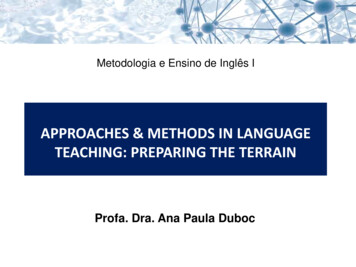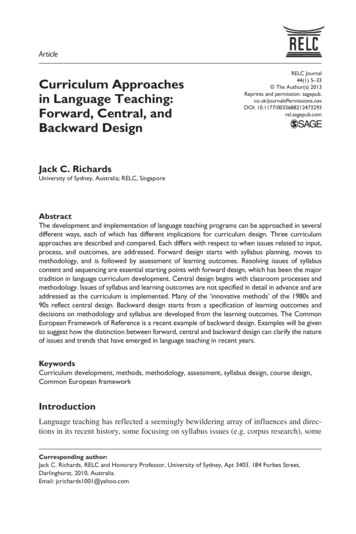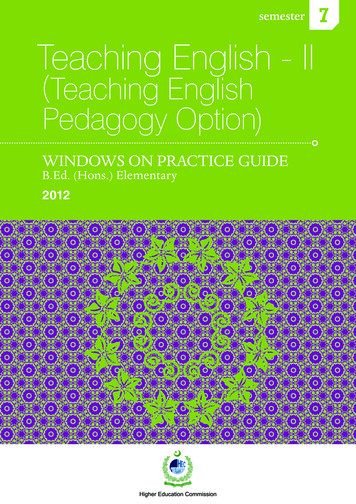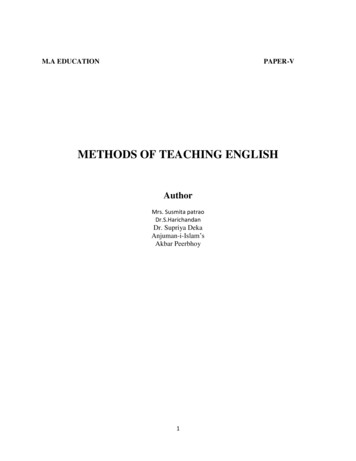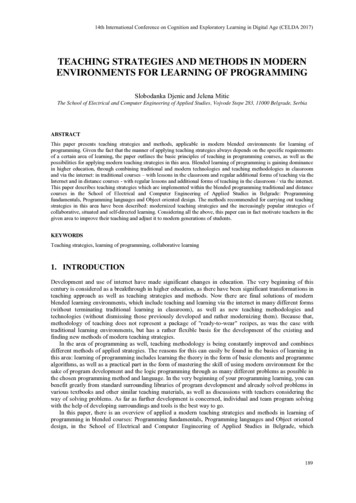
Transcription
14th International Conference on Cognition and Exploratory Learning in Digital Age (CELDA 2017)TEACHING STRATEGIES AND METHODS IN MODERNENVIRONMENTS FOR LEARNING OF PROGRAMMINGSlobodanka Djenic and Jelena MiticThe School of Electrical and Computer Engineering of Applied Studies, Vojvode Stepe 283, 11000 Belgrade, SerbiaABSTRACTThis paper presents teaching strategies and methods, applicable in modern blended environments for learning ofprogramming. Given the fact that the manner of applying teaching strategies always depends on the specific requirementsof a certain area of learning, the paper outlines the basic principles of teaching in programming courses, as well as thepossibilities for applying modern teaching strategies in this area. Blended learning of programming is gaining dominancein higher education, through combining traditional and modern technologies and teaching methodologies in classroomand via the internet: in traditional courses – with lessons in the classroom and regular additional forms of teaching via theInternet and in distance courses - with regular lessons and additional forms of teaching in the classroom / via the internet.This paper describes teaching strategies which are implemented within the blended programming traditional and distancecourses in the School of Electrical and Computer Engineering of Applied Studies in Belgrade: Programmingfundamentals, Programming languages and Object oriented design. The methods recommended for carrying out teachingstrategies in this area have been described: modernized teaching strategies and the increasingly popular strategies ofcollaborative, situated and self-directed learning. Considering all the above, this paper can in fact motivate teachers in thegiven area to improve their teaching and adjust it to modern generations of students.KEYWORDSTeaching strategies, learning of programming, collaborative learning1. INTRODUCTIONDevelopment and use of internet have made significant changes in education. The very beginning of thiscentury is considered as a breakthrough in higher education, as there have been significant transformations inteaching approach as well as teaching strategies and methods. Now there are final solutions of modernblended learning environments, which include teaching and learning via the internet in many different forms(without terminating traditional learning in classroom), as well as new teaching methodologies andtechnologies (without dismissing those previously developed and rather modernizing them). Because that,methodology of teaching does not represent a package of "ready-to-wear" recipes, as was the case withtraditional learning environments, but has a rather flexible basis for the development of the existing andfinding new methods of modern teaching strategies.In the area of programming as well, teaching methodology is being constantly improved and combinesdifferent methods of applied strategies. The reasons for this can easily be found in the basics of learning inthis area: learning of programming includes learning the theory in the form of basic elements and programmealgorithms, as well as a practical part in the form of mastering the skill of using modern environment for thesake of program development and the logic programming through as many different problems as possible inthe chosen programming method and language. In the very beginning of your programming learning, you canbenefit greatly from standard surrounding libraries of program development and already solved problems invarious textbooks and other similar teaching materials, as well as discussions with teachers considering theway of solving problems. As far as further development is concerned, individual and team program solvingwith the help of developing surroundings and tools is the best way to go.In this paper, there is an overview of applied a modern teaching strategies and methods in learning ofprogramming in blended courses: Programming fundamentals, Programming languages and Object orienteddesign, in the School of Electrical and Computer Engineering of Applied Studies in Belgrade, which189
ISBN: 978-989-8533-68-5 2017constantly follows and applies advances in education. Mentioned courses are developing in this School, inclassical and distance studies since 2012/13 academic year.Simultaneously, this paper touches current questions in higher education, such as: How do you keeptraditional methods and strategies that are proven to be efficient, but at the same time introduce new ones,supported by modern technologies and which are of great importance to new generations of students? Howdo you enable students to be active in certain segments of lessons and not just passive observers? How doyou obtain and maintain the collaborative teacher-student relationship?2. TEACHING STRATEGIES - FROM TRADITIONAL TO MODERNIf we consider teaching strategies in modern learning environments, we cannot generalize when it comes toadvantages of ones over the others, nor when it comes to strategies and their methods which areunchangeable. For developing highly efficient learning environments in any area, depending on the specificrequirements and available experience of the already developed environments, it is necessary to chooseteaching strategies, and after this gradually implement all the acquired experience with the applied strategiesinto their further development.Teaching strategies in modern blended learning environments [Petrina, 2007] are student-oriented: Thestructure of learning environment is totally adjusted to students; The process of teaching is fully directed tostudents; During the teaching, the students are encouraged not only to take in information, but do moreresearch, critically contemplate on the teaching material, perform individual or team work on solving specificproblems they encounter during teaching; Both teachers and students are simultaneously encouraged tocontinuously, during the process of teaching and learning, act as a team which cooperates in this process[Hart, 2014].To make a suitable choice of strategies in a certain area, it is first of all necessary to study generalcharacteristics of specific actual teaching strategies [Bullen, Janes, 2007]: Direct Instruction Strategy – implies learning from the previously defined content of the teachingmaterial, prepared by the teacher. The traditional direct instruction strategy mostly involved a passiveabsorption of the content by the students, while with modern forms of the same strategy, a constant studentactivity in the process of teaching and learning is implied, due to the existence of internet platforms whichstimulate active learning, and interactive content of the teaching material [Ruth, 2008]. Collaborative Learning Strategy – means learning through communication on the teaching materialbetween teacher and students and among students themselves, as well as an active student teamwork onproblems and projects, or simply put - a cooperation between teachers and students in the process of learning,a live one, but also with the help of different modern web tools for communication and online teamwork.With modern forms of this strategy, the process of teaching is rather adjusted to individual students. Situated Learning Strategy – means learning through practical problem solving, practical exercises,experiments, seminar papers and projects, all accompanied by the instructions and help of the teachers, andsupported by a wide spectrum of web and multimedia technologies, animations and simulations in virtuallabs. Modern forms of this strategy enable a rather active participation of students in the process of teaching. Self-directed Learning Strategy – means learning from the teaching material, as little as possiblerecommended by the teacher, and as much as possible researched by the students themselves. Earlier formsof this strategy involved researching of the printed material, and its modern forms also require browsing thematerial on internet platforms for learning, web pages, wikis, blogs and social networks. This strategy ischaracterised by active student involvement, and the process of teaching adjusted to their individual needs.Each modern teaching strategy requires a special approach to teaching, and specific forms of teachingorganisation, as shown in Table 1.Table 1. Basic characteristics of modern teaching strategiesTeaching strategyDirect InstructionCollaborative LearningSituated LearningSelf-directed Learning190Approach to teachingLearning TransmissionLearning in SocietyLearning EnvironmentLearning through ResearchForms of organising teachingWorking on presenting the contentWorking on preparing cooperation in learningWorking on preparing practical work in learningWorking on preparing for research in learning
14th International Conference on Cognition and Exploratory Learning in Digital Age (CELDA 2017)There is no universal recipe for choosing a teaching strategy and method in blended learningenvironment. Experience shows [Bonk, Graham, 2006.] that choosing the right blended model presents avery important step there. If a model is well chosen there are conditions for its implementation - with the useof appropriate strategies and methods - to give the expected results. Experiences also show that the choice ofstrategy and method, which is made according to the instructional design for every particular blended model,is just a guideline for the further development of teaching activities. Encouraging active student participationin teaching, continuous communications and cooperation between teacher and students, provide outlines andwithin them teachers’ and students’ activities are further formed.This paper further presents experiences in the choice and use of teaching strategies and methods indeveloped and implemented blended learning environment for teaching of programming in the School ofElectrical and Computer Engineering of Applied Studies in Belgrade: in classical studies – with the initially applied basic blended learning environment model, along with theadvanced blended learning model, from school year 2006/7; in distance studies – with the advanced blended learning environment model from school year 2012/13.3. MODERN ENVIRONMENTS FOR PROGRAMMING COURSESWhen selecting the teaching strategies which will be used in a specific area through their methods, it is, atvery start, necessary to take into account the specificity of the area in question and basic principles ofteaching in this area. The coming section of this paper gives a brief overview of the basic principles ofteaching in programming courses.3.1 Basic Principles of Teaching and Contents Specifics in ProgrammingCoursesModern learning environments for programming [Djenic, Krneta and Mitic, 2011], [Hadjerrouit, 2007],[Hadjerrouit, 2008] are constantly improved so they would be more efficient, but at the same time, they usebasic principles of teaching programming, which are given below: Teaching theory is a guideline for praxis - although it goes without saying that every programminglanguage can be learned best through praxis, the best "guide" for it, just like in all the other areas, is theory.Teaching theory here implies learning the syntax, definitions of certain groups of programme elements, themanner of connecting these elements, algorithms and methods of their application in programmes; Practical teaching is crucial – a programming is mainly learned through practical work on theprogrammes. Practical teaching in this area involves giving instructions and help in solving problems in aspecific programming language, initially based on the examples of solved programmes in the same language,and later in finding original solutions for diverse problems of programme tasks, within exercises and projects; The principle of connection between theory and praxis – the theory of programming is a precondition forpractical work in this area, since it is essential that students adopt it before beginning with the analysis of thecompleted programme solutions. On the other hand, practical work on programme tasks may serve tostudents to better grasp the theory and check the importance of theoretical knowledge; The principle of availability - to prevent certain concepts in the area of programming from being abstract,their descriptions should be clear and available - adjusted to students and based on the pre-knowledgeexpected from them. When teaching any programming language, it is necessary to explain them. In modernconditions, this is considerably supported by multimedia; The principle of active student role – in learning of programming, the priority has always been in theactive role of students. Students are expected to show initiative, work individually or in teams on problemsolving, ask questions in order to clarify certain situations they encounter in problem solving, and participatein discussions on the teaching material with teachers. In all this, web tools are used quite efficiently; Principle of interaction - student-teacher, student-student and student-content type of interactions arequite important in the theoretical and practical part of teaching in this area. In today's conditions interactivityis rather present, given the development of multimedia content, animations and simulations, which requireconstant student activity, together with different forms of online communication on the teaching material;191
ISBN: 978-989-8533-68-5 2017The forms in which certain segments of the content in this area are prepared are: theory in lessons,examples of solved programmes, programming tasks and questions: Theory in lessons can be prepared in the form of: text with programme elements definitions; illustrationswith algorithms of basic programming structures. Electronic materials can have an addition: interactivelesson content, animations which complement or substitute the text, the purpose of which is to explainabstract concepts to students, through their visualization; Examples of solved programmes usually contain: text with the source code and additional explanation ofthe source code programme and illustrations with memory overview and programme execution output.Electronic editions of solved programme collections can also contain: interactive textual content forprogramme examples; animations for explaining the itinerary of programme execution and; Programme tasks should be systematized into those for research, team and individual homework, seminarpaper or project, and prepare as a text of concrete tasks which should be solved in the required programminglanguage, possibly with illustrations. In the electronic form the text of the task can be a content within theinteractive applications, uploaded via the forum or other web tools; Questions in this area, with: connecting programme elements and their descriptions, alternative choice,multiple choice, filling in the programme elements or open-type. Just like tasks, the questions in theelectronic form can be prepared within interactive applications of all kinds.3.2 Development of Modern Blended Programming CoursesModern blended learning environment [Bonk, Graham, 2006] is a environment the purpose of whichadjustment to new the generation of students, which is achieved through combining of different: media andtechnologies in learning and teaching [Picciano, Dziuban, 2007]; teaching approaches, strategies andteaching methods; classroom and learning via internet.In the first blended learning environments, classroom learning and teaching were dominant. The constantdevelopment of interactive multimedia, web systems and technologies, created a possibility for thedevelopment of new learning environments, and that was a significant step in the development of theseenvironments. In modern blended learning environments, the following principles are insisted upon:adaptable classroom, flexible learning time, individual learning dynamics, regular communication throughoutteaching and learning. Unlike the traditional learning environments, in which it was possible to implementonly the original forms of the mentioned strategies of teaching of programming, modern blendedenvironments introduce the internet, and partly become virtual, as shown in Table 2.Table 2. Current strategies in the learning of programming and the environmental change for their realizationTeaching strategyDirect InstructionCollaborative LearningSituated LearningSelf-directed LearningForms of learningListening, reading and analysingTeam work; Exchange of ideasPractical workResearching, revealing solutionsTraditional environmentClassroom, computer labComputer labComputer labComputer labModern environmentWeb platform for learningWeb tools for teamworkVirtual labWeb resources; Virtual labBlended courses implies using knowledge and experience of traditional environments, but it is necessaryto work extra on broadening this knowledge and experience in modern conditions: Basic blended model of teaching (enhanced f2f learning) - realised within traditional studies, with 100%classroom lessons and extra forms of teaching via the internet; Advanced blended model of teaching (f2f & online, more online learning) - realised within distancestudies: by substituting about 90% of all the lessons by online lessons, and realising via the internet alladditional forms of teaching. Here too, the internet platform is using for online lessons and additional formsof teaching, but with much more complete teaching material: recordings of classroom lessons / audio-videopresentations / multimedia textbooks with interactive simulations / applications for knowledge check.Perennial research in the area of modern teaching methodology for programming by the authors of thispaper, resulted in the development and realization of blended courses in this area, according to basic blendedmodel of teaching in classical studies and according to advanced blended model of teaching in distancestudies since, 2012/13 academic year. The teaching plans for these courses, Programming fundamentals,Programming languages and Object oriented design, are shown in Table 3.192
14th International Conference on Cognition and Exploratory Learning in Digital Age (CELDA 2017)Table 3. Teaching plan for described programming courses"Programming fundamentals" topicsStructural programming, Algorithms of the program structures, language CData types, Operators and standard functions, Commands for flow control, language CArrays, Sorting of arrays, Use of pointers in arrays, Functions, language C"Programming languages" topicsDynamic memory assignment, Data structures, Dynamic linked lists, languages C/C Data input from command line, Working with text- and binary files, languages C/C Modular programming, language C, I/O streams, Classes and objects, language C "Object oriented design" topicsClasses features, Encapsulation, Inheritance, Polymorphism, language JavaData and expressions, Working with data bases, Exceptions, language JavaClass diagrams, Activity Diagrams, Basic concepts of program design, language Java4. EXPERIENCES IN APPLYING MODERN TEACHING STRATEGYMETHODS IN PROGRAMMING COURSESEvery teaching strategy defines its own methods for interaction in the process of teaching and learning:teacher-content, student-content, teacher-student and student-student. Different strategies use differentmethods with various levels of teaching control and student activity in the teaching process, for the fulfilmentof all these types of interaction. The same goes for the area of programming.4.1 Modern Teaching Strategy Methods Implemented in ProgrammingCoursesShort descriptions of modern teaching strategy methods which are implemented in blended courses ofprogramming in the School of Electrical and Computer Engineering of Applied Studies in Belgrade, areshown in Table 4.Table 4. Modern strategy methods implemented in the programming coursesTeaching atedLearningSelf-directedLearningThe most common activities in the classroom / via the internetTeachers’ activities:Lecturing, presenting and reviewing programme elements and algorithms; Instructionson learning programme syntax; Demonstration on completed solved programmes;Students’ activities:Interactive lectures following; Asking questions regarding elements and algorithms andcompleted solved programmes;Teachers’ activities:Creating working teams or suggestions on the same; Instructions for team problemsolving; Leading the discussion on the material;Students’ activities:Team projects and problem solving; Active in the discussion on the material andproblems; Indication of discussion on the lectures and problems;Teachers’ activities:Instructions for using developed tools and surroundings; Instructions on programmesolving and exercises; Instructions on writing programme seminars;Students’ activities:Mastering using developed tools and surroundings; Programme solving; Writingprogramme seminars; Solving potential practical problems; Working on simulations ofpreviously solved programmes; Researching previously solved programmes;Teachers’ activities:Directions and recommendations for research on certain subject;Students’ activities:Researching all of the subjects; Partial or complete reviews; Professional practice;193
ISBN: 978-989-8533-68-5 2017In modern environments for learning of programming, relation between present types of teacher andstudent activity is significantly changed compared to traditional systems [Watkins, 2005]. There were manymore forms of teachers’ activities in the lecturing strategy which dominated in the traditional learningenvironment whereas now it is insisted upon the change of this relation because certain forms of students’ arepresent in the same level or more in some learning strategies which can be seen in Figure 1.Figure 1. The relation between present forms of teachers’ and students’ activities in some modern teaching strategies forprogramming: direct instruction, collaborative, situated and self-directed learningExperiences in applying above mentioned teaching strategies and methods in implemented blendedlearning environment in programming courses are briefly described further in this paper.Experiences in applying modern teaching strategy methods - new forms for presenting teachingmaterial with interactive smart board and internet access are very important for lessons in programming.Teaching materials can be available on the web, audio/video recordings of lessons in classrooms can befollowed online or downloaded and used locally, watching audio/video material can be delayed and possiblean arbitrary number of times, lessons and consulting can be implemented through audio/video conferencesand other communication tools - this requires more teachers' than students' teaching activities.Experiences in applying the collaborative learning method - cooperation is very important in modernlearning environments. Discussions have become a necessary method in the collaborative learning strategybut also, the commonly used method in other modern strategies in learning of programming. It is no longer aquestion whether discussions should be included in programming courses because the experiences in theirimplementation show that they can offer great help to all participants - this requires the around same amountof teachers' and students' teaching activities.Experiences in applying the situated learning strategy - this strategy demands that students practicesolving problems that appear in real situations by simulating real conditions in programming. Students thatlearn in a blended environment get the chance to learn in a more situated manner because their participationin teaching and learning outside of the traditional classroom requires exactly that. Practical work commonlyprovides better understanding of abstract terms and success in studying after reading and listening to theoryof programming - this requires more students' than teachers' teaching activities.Experiences in applying the self-directed learning method - in this strategy, students are givenrecommendations and are free to research and get familiar with the theory that way and solve practicalproblems in programming. This strategy is used in different ways: checking material, essays and reports oncovered teaching content on wiki pages and on blogs, practice in an online lab, working on tasks with thehelp of web tools. Practicing the use of this strategy in programming shows that it is very useful if studentshave mutually different pre-knowledge - this requires much more students' than teachers' teaching activities.4.2 Recommendations: Modern Teaching – Enterprise of Teachers andStudentsExperience from blended environments on the large number of programming courses ensuesrecommendations for the preparation of such teaching:194
14th International Conference on Cognition and Exploratory Learning in Digital Age (CELDA 2017)use good experience with traditional teaching strategies and methods;set out all the conditions for realisation of the new teaching activities, long before the planned course;involve consultants in the specific area and pedagogy in the preparation of the new teaching activities;prepare online platform for learning, as well as all other planned web tools for the new teaching activities;make a detailed plan of teaching activities;try, if possible, to realise the planned teaching activities with other teachers;formulate the rules for the individual and team work for students;prepare the plan for communication with students about the teaching material;Technology changes strategies and methods of teaching and consequently the roles of teachers andstudents. Experience suggests that the basic condition for modernizing teaching is that teachers acceptinnovations in order for students to do the same.Teachers get new, highly demanding roles and assignments, but also an opportunity to have insight intolearning methods of their students and to familiarize themselves better with them.Students assume a very active role, while teachers are always available to answer all their questions,comments and objections related to the teaching material. 4.3 Development Trends and Future Research of Teaching MethodsThere are high expectations for the results of future research in teaching strategies and methods, consideringthe constant development of new technologies and new roles of teachers and students. It is the sameexpectations in the area of programming: development of the learning environment for mobile devices constitute "mobile classroom" - teachingmethods for programming are expected to be improved with:- uploading and views of audio / video content of lessons and exercises, instructions for tasks andpractical work in programming – in mobile devices;- regular knowledge self - checks and discussions on teaching material and tasks - via mobile device;- teachers' and students' use of mobile devices in programming courses, both outside the classroom andin it, which represents trend of "bring your own device" in working context. development of the learning environment with distance online tools, in the form of virtual classroomconstitute so called "classroom in the cloud":- preparing, development and views of lessons, exercises, knowledge self - checks and discussions onteaching material - on the cloud, without installing any kind of tools in local teachers' and students'computer devices;- working on solutions in programming, design, implementation and testing of code - on the cloud;- teachers' and students' activities more reliable and adaptive, free of charge or very affordable due tothe reduced need for the local maintenance of programming environment and tools. development of the learning environment, web platforms, teaching materials and activities in the blendedclassroom, so called "flipped classroom":- outside the classroom: preparing, downloading, uploading and views of lessons, work instructions,programme examples and tasks;- outside the classroom: working on programme solutions, design, implementation and testing of code;- in the classroom: views of teaching material, questions and answers, discussions on teaching materialand knowledge checks.Blended learning environments for programming have already entered the practice of highly renownededucation institutions all around the globe [Djenic, Krneta and Mitic, 2011]. In this area, like in all others,current teaching methods are constantly being modernized and the new ones are being developed, and theconcept of teaching has shifted towards flexible cooperation between teachers and students.195
ISBN: 978-989-8533-68-5 20175. CONCLUSIONContinuous work on the modernization of traditional, and the development of new teaching strategies andmethods, as well as their application to modern blended learning environments, is currently an importantstrategic move in the development of higher education.Learning of programming is closely related to the development of modern information andcommunication technologies, and it is therefore vital to continuously apply the latest achievements of modernteaching methodology in this area.Perennial research in the area of modern teaching methodology for programming by the authors of thispaper, indicated that the methods of all current teaching strategies are preferred in this study area. Modernteaching strategy methods incorporate interactive multimedia and interaction in teaching, which areimportant for this study area; Collaborative learning methods develop greatly needed creativity in solvingprogramme tasks and stimulate the vital exchange of programming experience; Situated learning methodsincrease motivation and students' interest in solving programme problems, which are dominant in this studyarea; Self - directed learning methods capacitate student for lifelong development in this area, which isimportant for the further development of techn
ENVIRONMENTS FOR LEARNING OF PROGRAMMING . Slobodanka Djenicand Jelena Mitic . The School of Electrical and Computer Engineering of Applied Studies, Vojvode Stepe 283, 11000 Belgrade, Serbia . ABSTRACT . This paper presents teaching strategies and methods, applicable in modern blended e


